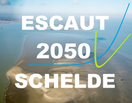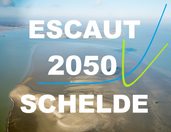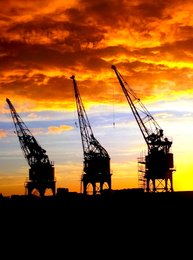EscautSchelde2050
Cross-border cultural, scientific and touristic cooperation around the Scheldt region, calling the attention to the importance of sustainable management.
CLIMATE CHANGE IN THE SCHELDT DISTRICT
KLIMAATVERANDERING IN HET SCHELDEDISTRICT
CHANGEMENT CLIMATIQUE DANS LE DISTRICT DE L'ESCAUT
Conference on Friday 25.10.2019 from 8.30 h till 12.30 h
Natiënhuis, Jordaenskaai 25, 2000 Antwerpen
Invloed op het dichtbevolkte Scheldegebied van de gecombineerde effecten van klimaatverandering en sociaal-economische ontwikkelingen, een belangrijke uitdaging voor duurzame ontwikkeling in de 21e eeuw.
De ligging aan de Noordzee maakt het dichtbevolkte Scheldegebied erg kwetsbaar voor de extreme weersomstandigheden die erop afkomen door de klimaatopwarming. Dit is geen nieuw fenomeen want mens en rivier hebben in het verleden ook overstromingen, droogte of ijstijden gekend, Geologisch bewijs suggereert dat de gevolgen van klimaatveranderingen in het verleden zeer extreem waren. Begrijpen en voorspellen hoe menselijke activiteiten samen evolueren naar de toekomst door nieuwe referentieomstandigheden is een interessant
Menselijke acties hebben altijd een integrale, zo niet dominante, invloed gehad op de ecologische werking en de vormgeving van riviersystemen en hun omgeving, met belangrijke implicaties voor de ontwikkeling van het rivierbeheer. Daarom vereist de analyse van het riviersysteem dat menselijke activiteiten samen met natuurlijke factoren worden bestudeerd in het diagnostische proces. Huidige onderzoekmethoden geven een beter zicht op hoe men toen met de rivier is omgegaan en wat we daaruit kunnen leren voor de toekomst.
Ecosystemen van rivieren ondersteunen belangrijke biologische functies: verplaatsing van voedingsstoffen, matiging van overstromingen, behoud van biodiversiteit en biologische productie. Ze zijn uniek, omdat ze een continuüm vormen in zowel ruimte als tijd tijdens de overgang van bron naar riviermonding. Ze vormen zo een complexe mix van verschillende habitattypen die onderling verbonden zijn. Er hebben zich grote veranderingen voorgedaan in de het rivierlandschap in de afgelopen eeuwen. Het droogleggen van moerasgebied voor landbouw, en later voor industrie en urbanisatie, de aanleg van dijken als bescherming tegen stormen, ingrepen die hebben geleid tot een aanzienlijk verlies van water- en luchtzuiverende biotopen.
Nieuwe technologie en versnelde mediacommunicatie hebben economische welvaart en vooruitgang in het wetenschappelijk onderzoek met zich meegebracht, maar helaas ook overconsumptie en milieuvervuiling. Gasemissies afkomstig van landbouw en industrie versnellen het proces van de opwarming van de aarde. Door het smelten van de ijspolen, verhoogt het zeeniveau en wordt het klimaatevenwicht verstoord. Europa wil tegen 2050 het eerste klimaatneutrale continent worden, een ambitieus plan dat veel geld zal kosten en bepaalde regio economisch en sociaal zwaar zal treffen in de periode van transitie. Economiespecialisten zeggen dat we het kapitalistisch model moeten herzien (Davos 2020).
Extreme weerspatronen, stijgende temperaturen en broeikasgasemissies brengen veranderingen in beleid en wetgeving met zich mee, die van invloed zijn op het bedrijfsleven. Een bloeiende economie heeft een lange termijnvisie voor mens en milieu. Er moet dringend opgetreden worden om de milieuschade te beperken. Dat begint bij het bewustzijn van bedrijven en overheden van hun eigen impact op de klimaatverandering. Investeerders, bedrijven, steden en overheden kunnen nu de juiste keuzes kunnen maken, aangezien ze zich steeds meer informeren over de risico's en kansen in dit opzicht. Bedrijven zien overigens ook marktkansen door duurzame bedrijfsactiviteiten.
Conclusie
Door bevolkingsgroei, verstedelijking, industrialisatie en agrarische activiteit is de druk op de Schelde sterk toegenomen. Het bewustzijn dat de natuur ook ademruimte nodig heeft en een mentaliteitsverandering betreffende water- en energieverbruik komt tot stand. Onder impuls van de Kaderrichtlijn Water werken de oeverstaten van de Schelde hun aangepaste Scheldebeheersplannen uit, in samenwerking met de Internationale en de Vlaams-Nederlandse Scheldecommissie. In combinatie met bescherming tegen overstromingen wordt land teruggegeven aan de rivier, met natuurherstellende resultaten tot gevolg. Het opslaan van regenwater moeten ons helpen onz te beschermen tegen periodes van extreme droogte..Klimaatverandering is geen nieuw fenomeen. Mens en rivier hebben in het verleden ook overstromingen en ijstijden gekend. Huidige onderzoekmethoden geven echter een beter zicht op hoe men in het verleden met de rivier is omgegaan en wat we daaruit kunnen leren voor de toekomst. Een nuttige denkoefening.
Adapting densely populated Scheldt District to the combined impacts of climate change and socio-economic developments, a major challenge for their sustainable development in the 21st century
The densely populated Scheldt area is particularly vulnerable to natural disasters due to its location on the North Sea. Therefore a deep reflection on the matter is important. Climate change is not a new phenomenon. Man and river have also experienced floods and ice ages in the past. Geological evidence suggests that the effects of climate change in the past were much more extreme. However, the current period of warming is occurring more rapidly than many past events. Scientists believe we are adding to the natural trap of solar energy by the atmospere with gases released from industry and agriculture (known as emissions), and increasing the temperature. Soil research in the Scheldt area provides a picture of part of this past and can help to better understand the current situation. Understanding and predicting how human activities co-evolve from new reference conditions into the future may be productive. Human actions have always had an integral, if not dominant, influence on the ecological functioning of river systems, with important implications for the development of river management. Therefore analyzing fluvial systems requires that human activities be considered along with natural factors during the diagnostic process, and that analyzes are able to distinguish local, specific cause and effect differentiation.
Ecosystems of rivers support many functions: cycling and movement of nutrients, mitigation of floods and maintenance of biodiversity and biological production. They are naturally highly dynamic and rapidly changing, forming a complex mixture of many different habitat types. These habitats do not exist in isolation, but rather have physical, chemical and biological links between them. The ecosystems of rivers are unique because they form a continuum of both space and time during the transition from headwaters to the river mouth.
The Scheldt was continuously shaped and transformed by farmers, cities, princes, boatsmen, states, and all those generations of people which day-to-day interacted with the river for their livelihood, their entertainment or their safety. Their efforts, plans and dreams are still concealed in the soil and landscape of the Scheldt Region, waiting to be discovered. This caused major changes in the river landscape occurred during the last centuries. Since the early middle ages tidal marshes were reclaimed by embankment to create agricultural land, and later for industrial and urban developments. Intertidal habitat was also lost due to dike building, in order to protect the land against storm floods from the North Sea.
Extreme weather patterns, rising temperatures and greenhouse gas emissions entail changes in policy and legislation that have an impact on business. Thriving economy works for people and planet in the long term. We must act urgently to prevent dangerous climate change and environmental damage. That starts by being aware of our impact so that investors, companies, cities and governments can make the right choices now as they are increasingly informing themselves about the business risks and opportunities in that regard. Companies also see market opportunities for sustainable business activities. Population growth, urbanization, industrialization and agricultural activity have greatly increased the pressure on the Scheldt. Consciousness arises that nature also needs breathing space and that there must come a change in mentality for water and energy consumption.
Under the impetus of the Water Framework Directive, the riparian states of the Scheldt have worked out their Scheldt management plans in collaboration with the International Scheldt Commission. In combination with flood protection, land is returned to the river, with nature recovering results. However, climate change is not a new phenomenon. Man and river have also experienced floods and ice ages in the past. Current research methods provide a better insight into how people dealt with this in earlier times and what we can learn from it for the future. Scientist will speak you about these subjects on the conference of 25 October in Antwerp.
Adapter le District densement peuplé de l'Escaut aux effets combinés du changement climatique et des évolutions socio-économiques, un défi majeur pour le développement durable au 21ème siècle.
Les scientifiques prédisent des effets catastrophiques dus au réchauffement climatique. L'absorption naturelle de l'énergie solaire par l'atmosphère est favorisée par les gaz dégagés par l'industrie et l'agriculture. Les preuves géologiques suggèrent que les effets du changement climatique dans le passé étaient beaucoup plus extrêmes. Le problème est que la période de réchauffement actuelle se déroule plus rapidement que d’habitude, perturbant les fluctuations naturelles du climat et ayant de graves conséquences pour la stabilité du climat de la planète. Les ressources écologiques, culturelles et économiques de l'Escaut sont sous la pression des effets du changement climatique, La localisation près de la mer du Nord rend la zone densément peuplée de l'Escaut particulièrement vulnérable aux catastrophes naturelles. C'est pourquoi une réflexion en profondeur est importante.
Le changement climatique n'est pas un phénomène nouveau. L'homme et la rivière ont également connu des inondations et des périodes glaciaires dans le passé. Les preuves géologiques suggèrent que les effets du changement climatique dans le passé étaient beaucoup plus extrêmes. Les actions humaines ont toujours eu une influence intégrale, voire dominante, sur le fonctionnement écologique des systèmes hydrographiques, avec des implications importantes pour le développement de la gestion des rivières. Par conséquent, l'analyse des systèmes fluviaux nécessite que les activités humaines soient prises en compte avec les facteurs naturels lors du processus de diagnostic. Ce défi nécessite de nouvelles méthodes d'analyse qui s'appliquent aux échelles historiques, spatiales et temporelles. Comprendre et prévoir comment les activités humaines évolueront dans l'avenir à partir de nouvelles conditions de référence pourraient être productifs.
Les écosystèmes fluviaux accomplissent de nombreuses fonctions importantes: cycle et circulation des éléments nutritifs, atténuation des inondations et maintien de la biodiversité et de la production biologique, formant un mélange complexe de nombreux types d'habitats différents qui ont des liens physiques, chimiques et biologiques entre eux. Des changements majeurs dans le paysage géographique de l’Escaut se sont produits au cours des derniers siècles. Depuis le début du moyen âge, les marais à marée ont été reconstitués pour l’agriculture et plus tard pour l’industrie et l’urbanisation les digues devaient protéger les terres contre les tempêtes de la mer du nord, entraînant une perte supplémentaire de marais.
Les conditions météorologiques extrêmes, la hausse des températures et les émissions de gaz à effet de serre entraînent des modifications de la législation qui ont une incidence sur les affaires. Une économie florissante doit avoir une vision à long terme pour la planète et l'environnement. La prévention des effets du changement climatique et des dommages environnementaux est urgente. Cela commence par la sensibilisation des entreprises et des gouvernements de leur propre influence aux causes du changement climatique. Les investisseurs, les entreprises, les villes et les gouvernements peuvent désormais faire les bons choix, car ils sont de plus en plus informés des risques et des opportunités à cet égard. Les entreprises voient également des opportunités de marché pour des activités commerciales durables. En raison de la croissance démographique, de l'urbanisation, de l'industrialisation et de l'activité agricole, la pression sur l'Escaut s'est accrue. On prend conscience que la nature a aussi besoin de répit et qu'il faut changer de mentalitéen ce qui concerne la consommation d'eau et d'énergie.
Sous l'impulsion de la directive-cadre sur l'eau, la France, la Belgique et les Pays-Bas ont élaboré leurs plans de gestion de l’Escaut en collaboration avec la Commission internationale de l'Escaut. En combinaison avec la protection contre les inondations, des terres sont retourné à la rivière. Cependant, le changement climatique n'est pas un phénomène nouveau. L'homme et la rivière ont également connu des inondations et des périodes glaciaires. Les méthodes de recherche actuelles donnent une meilleure idée de la façon dont les gens ont traité la rivière dans le passé et de ce que nous pouvons en tirer pour l'avenir.















